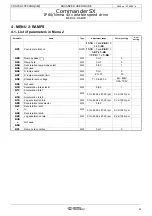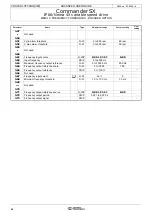
34
ADVANCED USER GUIDE
IP66/Nema 4X variable speed drive
MENU 2: RAMPS
CONTROL TECHNIQUES
3854 en - 03.2008 / b
4.3 - Explanation of parameters in menu 2
: Post-ramp reference
Adjustment range : • If
1.10
= 0 and
2.02
= 0: 0 to
1.06
• If
1.10
= 0 and
2.02
= 1:
1.07
to
1.06
• If
1.10
= 1: ±
1.06
Measurement of the post-ramp reference. Used for
diagnostics.
: Ramp bypass (
)
Adjustment range : 0 or 1
Factory setting
: 0
0 (Off) (no): Active ramps.
1 (On) (raMP): Ramps short-circuited.
: Ramp hold
Adjustment range : 0 or 1
Factory setting
: 0
0 (Off) (raMP): Ramp freed.
1 (On) (StoP): The ramp is held and acceleration (or
deceleration) is therefore interrupted.
WARNING:
The ramp hold function is disabled if a stop command is
given.
: Deceleration ramp mode select
Adjustment range : 0 to 3
Factory setting
: 1
0 (Fast) (Fst): Deceleration ramp imposed. If the deceleration
ramp that has been configured is too fast in relation to the
inertia of the load, the DC bus voltage exceeds its maximum
value (set in
2.08
) and the drive trips on "OU" overvoltage.
WARNING:
Select mode
2.04
= 0 (Fst) when a braking resistor is
used.
1 (Standard) (Std): Standard deceleration ramp with
automatic extension of the ramp time in order to avoid
causing a DC bus overvoltage trip on the drive (threshold
set in
2.08
).
2 (S) (StdH): The drive allows the motor voltage to
be increased up to 1.2 times the rated voltage set in
5.09
(motor rated voltage), to avoid reaching the maximum DC bus
voltage threshold (threshold set in
2.08
). However, if this is
not sufficient, the standard deceleration ramp time is
extended, to avoid causing a DC bus overvoltage trip on the
drive.
For the same amount of energy, mode 2 enables faster
deceleration than mode 1.
3 (Fast+) (FstH): Same as mode 2, but the ramp is imposed.
If the configured ramp is too fast, the drive goes into OU trip
state.
WARNING:
In mode 2 and 3, the motor must be capable of tolerating
additional losses relating to the increase in voltage at its
terminals.
: Not used
: S ramp enable
Adjustment range : 0 or 1
Factory setting
: 0
0 (Off) (Lin): The ramp is linear.
1 (On) (S-rP): A curved part (defined in
2.07
) at the start and
end of the ramp avoids load swinging (S ramp).
WARNING:
The S ramp is deactivated during controlled
decelerations (
2.04
= 1 or 2).
: S ramp acceleration limit
Adjustment range : 2 to 10
Factory setting
: 10
Used to modify the ramp curve by the same value at the start
and end of the ramp.
The value 4 represents a time for the curved part of 25% of
the total ramp and 10 represents a time for the curved part of
10%.
: Standard ramp voltage
Adjustment range : 0 to 800 V
Factory setting
: Eur: 690 V, USA: 750 V
This threshold is used when the drive is configured in
standard deceleration mode (
2.04
= 1 or 2).
If this threshold is too low, the machine will stop in freewheel
mode. If this threshold is too high and there are no resistors
connected, the drive will trip due to DC bus overvoltage ("OU"
trip).
The minimum value of this parameter must be 50 V higher
than the DC bus voltage obtained with the maximum supply
voltage (U bus = U supply x
√
2).
: Not used
: Acceleration rate selector
Adjustment range : 0 to 9
Factory setting
: 1
This parameter is used to select the acceleration ramp as
follows:
0 (Term. inputs) (SEL): Selection of the acceleration ramp
via digital input. The choice of ramp comes from the binary
sum in menu 9 (
9.32
).
1 (Acceler.1) (Acc1): Acceleration ramp 1
2 (Acceler.2) (Acc2): Acceleration ramp 2
3 (Acceler.3) (Acc3): Acceleration ramp 3
4 (Acceler.4) (Acc4): Acceleration ramp 4
5 (Acceler.5) (Acc5): Acceleration ramp 5
6 (Acceler.6) (Acc6): Acceleration ramp 6
7 (Acceler.7) (Acc7): Acceleration ramp 7
8 (Acceler.8) (Acc8): Acceleration ramp 8
9 (To preset) (rP.Pr): The ramp is automatically associated
with the corresponding preset speed.
2.01
2.02
2.03
2.04
2.05
2.06
2.07
2.08
2.09
2.10
















































